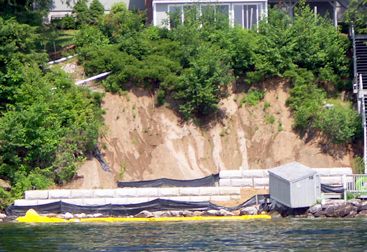Quote:
Originally Posted by MAXUM

The problem with Canada geese is there are way to many of them and controlling their population never seems to be a consideration. They make a mess no matter where they go beaches, golf courses, public and private property. Instead of increasing hunting for these pests to help reduce the overall numbers it's better for some reason to shoo them onto somebody else's property or move them elsewhere which of course never works as they will come right back. So the quandary continues do we take care of the problem or let those things continue to procreate and grow in numbers that are not proportional to taken by natural predators or hunting.
I do find it a bit hard to believe that all or a good majority of the silt in the lake is from bird poop otherwise the water would be toxic to swim in, they may contribute some organic matter but not at a volume that could possibly be measurable.
|
MAXUM is correct about
silt.
"Silt" is
inorganic in origin:
Quote:
|
Definition of silt. 1 : loose sedimentary material with rock particles usually 1⁄20 millimeter or less
|
Dense forest growth (especially pine) reduces the amount of silt washed downslope by heavy rains
everywhere in the Winnipesaukee Basin.
Last week, I checked out the source of a loud wood-chipper sound nearby. It was a new neighbor who had cut down eight huge White Pines from his shorefront. The nearest stump to be seen was about 30-inches across. (The width of a typical refrigerator). The "trimmer's" name? "
Urban Tree Service".

Wave actions—but especially large boat wakes—wash heavier silt from shorefronts. While some "silt" washed downslope introduces "sand"—where it didn't appear before—the finer particles can be expected to coat the lake's bottom
locally.
For example, three decades of construction on The Broads side of Wolfeboro Neck—and Rattlesnake Island—has changed those locales. By kayak, I remember seeing a kaleidoscope of colors and textures on every rock on the bottom. Presently, they all appear similarly-textured and "olive" in color. 'Wonder why?



In some states, a "Rain Tax" would have been imposed on the abutters!

Is "Rain Tax" another name for "View Tax"?

________________________
Canada Geese may be getting a "bad rap" for Gilford's waters. DNA examinations—
which may be in process presently—can determine if the source of
E. coli is mammal, fish,
vegetable, or (foul) fowl. Presently, the entire state of New Hampshire is affected by an outbreak:
http://www.ecoliblog.com/e-coli-outb...9#.V53iO-RTF-w
While
FLL's referenced article has expired for non-subscribers,
The Citizen newspaper has published many
E. coli articles just for the year 2016:
http://www.citizen.com/search/node/coli
Also remember that Canada Geese are "invited" to the area by
maintaining green-grass lawns.

The nutrients of Phosphorus and Nitrogen from lawn fertilizers "grow" the lake's algae—and the algae "grow" the snails that produce Duck Itch.
 .
.